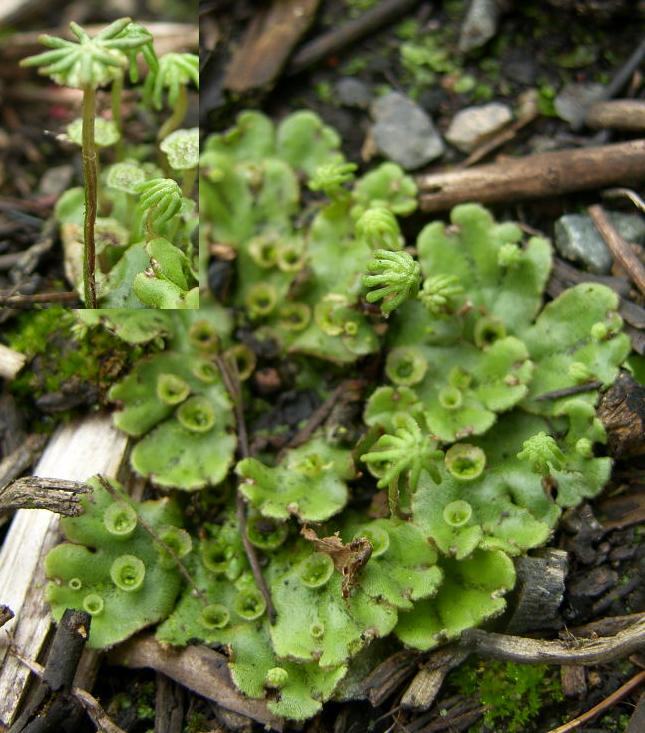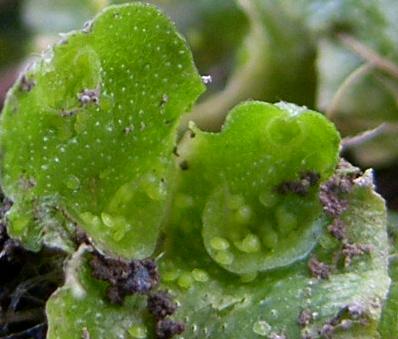LiverwortScientific Name: Marchantia polymorpha |
Liverworts along with mosses, belong to a group of plants known as the Bryophytes and grow on the surface of soil where the drainage is poor. There are about 289 species found in Britain. Marchantia polymorpha shown here, is very common in gardens and greenhouses. Evidence from spores from about 470 million years ago suggests that similar life forms to the liverworts may have been the first 'plant' life to establish out of water as algae moved onto land, which shows how relatively primitive they are in structure. There are no roots, no organised tissues to conduct water and nutrients nor stomata to regulate water loss; the waxy surface gives some protection, but in dry conditions the whole plant will shrivel.
There are two types of liverwort, the Leafy and the Thallose. Leafy liverworts have tiny, overlapping scale-like "leaves" arranged along a very fine stem and some can resemble a miniture fern.
The thick dark green, flattened structure of the Thallose type has upward-facing male reproductive structures like toadstools called antheridial stalks and female, parasol-shaped hoods borne on a stalk (archegonial stalks), resembling a miniature palm tree. There can be dioicous species with male and female parts on separate plants or monoicous species with the sexual parts on different branches of the same plant. When ripe the elevated capsules on the undersides of the female structures burst open and if conditions are favourable a new plant will develop from spores that are released.
There are also cup-shaped structures called cupules on the surface of a more mature thallus, these produce small green granules called gemmae by an asexual division, which are splashed out by raindrops and grow into new plants - see bottom picture.
There are fine fibrous root-like structures called rhizoids about 5mm long, in a row below the midrib on each thallus, these are for anchorage and water uptake, and make removal quite difficult. Because of their appearance, it was once believed that following the Doctrine of Signatures that liverworts could cure diseases of the liver, hence the name.
They spread by spores which are carried in the air and by the gemmae, so if the right conditions are present they will soon cover a flowerbed. If the lawn is compacted and poorly drained the grass will be sparce providing a perfect area for the liverwort to establish.
Sometimes they are found on the surface of potted plants, which can indicate that the plant has been in the container for too long, may be starved, poorly drained and the roots may have rotted or died back. Even if not present the pot may have been in the vicinity of some spores or gemmae, so discard the surface compost before planting.
If there is no mulch, use a hoe to keep the surface soil loose to about 3 to 4 cm deep. When a large area is covered the best solution is to slice off the Liverwort and apply fresh mulch.
Improve the drainage by adding grit and organic matter. A mulch of coarse bark chips should prevent establishment for a while but if it settles the spores of the Liverwort will soon take over in shaded, moist areas. In the lawn feed and improve drainage by pricking or aerating.
Winter frosts usually lift the tough growths so early spring is a good time to tackle it as it is loose on the surface of the soil and can be easily gathered up. This is usually easier where there is a mulch which will be partially removed and should be topped up.
Gravel which has been down for some time tends to become clogged with dust and leaf debris so the surface becomes an ideal medium that does not drain well. The top layer can be discarded and replaced or passed through a sieve and washed - a very laborious task.
Glyphosate will kill it, but should be applied with a few drops of detergent in the water to try to penetrate the waxy surface of the thallus. However, if it has been present for some time there will be gemmae present and it will return. Some say that using a weedkiller encourages Liverworts and Mosses to grow, but this could be that having removed all of the competition the ground is open for them to invade. Also if the ground has not been disturbed by uprooting the weeds the smooth compacted surface is more conducive to their establishment.
On paths a mosskiller should treat it, but if conditions for growth continue it will return. Removing shade and on hard surfaces, debris which could act as a substrate, should help.

Liverwort thalli with sexual and asexual reproductive structures.

The small, green, seed-like gemmae falling out of the cupule.